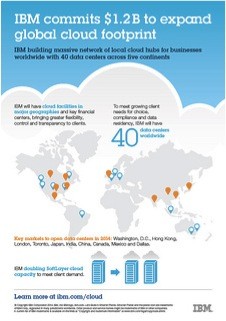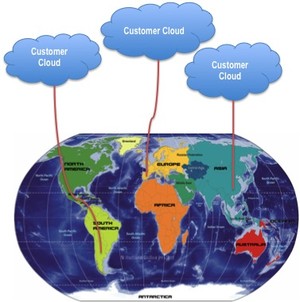Where Are Your Clouds? Location Matters!
Why Your Customer Data Belongs in the Cloud and Why You Need to Control Jurisdiction
Companies of all sizes are stampeding to take advantage of cloud computing. A lot of customers’ information is hosted in clouds. Customers want access to their information from any device and from anywhere. But personally identifiable information needs to be housed in the customer’s home country. Customer clouds—clouds containing the information that customers want to be able to access and interact with easily--should be country-specific.
NETTING IT OUT
Mobile apps and cloud computing are changing how companies invest in, develop, and deploy customer-impacting information technology. Cloud computing is seductive. You pay as you go. There’s no upfront investment. If done correctly, it’s just as secure as your own company’s data center.
One of the beauties of clouds is that you don’t care where the computers and the disks are. They can be housed in data centers anywhere in the world. But it turns out that clouds’ location do matter. If you care about your customers, and you want to stay out of jail, you’ll want to pay attention to where any clouds containing customers’ information are physically located.
Benefits of Cloud Computing
One benefit of Cloud computing is that your company no longer needs to own or invest in hardware or systems or data centers. You rely on specialist firms to do that at scale. Another benefit is that you can scale cloud computing up and down dynamically. No need to plan ahead and to order hardware, space, electricity, etc. in advance.
You pay as you go. You pay for the compute cycles and the data storage and the networking bandwidth you need.
When you want to launch a new system, you simply spin it up as a “virtual machine” in someone else’s compute farm. If the traffic on that system grows or spikes, it simply clones itself—and shrinks back when demand ebbs.
A variant of cloud computing (which is increasingly lumped into the same pot) is Software as a Service (SaaS). You no longer need to install software applications as systems that your company hosts and manages. Today, most software is available for people to use via the Web. As long as you have reliable Internet access, you can do everything you need to do without investing in hardware to run that software, and without worrying about keeping everything backed up or version control or security patches. It’s all taken care of by the supplier of the software. You don’t need to know or care “where” that software is physically housed (or do you)?
 Who Uses Cloud Computing Today?
Who Uses Cloud Computing Today?
All Start-Ups. Start-up high tech firms were the first to embrace cloud computing. Instead of raising $2 million to buy and host computers and to hire a staff to manage those computers, entrepreneurs can work from home, spin up computing in the cloud, and develop their new products by charging the monthly compute charges on their (or their parents’) credit cards. Now every start-up firm regardless of industry relies on cloud computing. Whether you’re launching a non-profit, a small clinic, a manufacturing firm, a store, a restaurant, or an art gallery, you’d be crazy to buy anything but a few laptops and phones and maybe POS (Point of Sale) devices. All of the software you need to run your business will be available via the Internet from the cloud. You don’t even have to have, or back up, your own hard disks. You do that automagically in the cloud.
Small and Medium Companies. Small and mid-size firms were the next to embrace the cloud. Many came to the cloud by procuring the software they needed to run their businesses using SaaS. This is software that is hosted by the supplier in the cloud. Users access the software via the Web. They may install client software or apps on their laptops and PCs and mobile phones, but most of the functionality and ALL of the data resides on the suppliers’ sites. Intuit QuickBooks is available as a SaaS. So is Basecamp for managing projects and sharing files with customers. You can backup all of your data from your various devices using a cloud service like DropBox. One of the most popular SaaS products and ecosystems is Salesforce.com—what data does it include? All of the data your firm has about customers and prospects. Where does it sit? Not in your data center, but in one or more of seven secure data centers that Salesforce.com provisions around the world. These are housed in data center and collocation facilities run by Equinix or NTT.
Large Companies. Large enterprises are big users of SaaS, particularly applications like Salesforce. They are also big users of cloud computing for developing prototypes of new systems and applications. As with entrepreneurial start-ups, enterprise development teams that are creating software proof of concepts, pilots, prototypes, or engaged in lean start-up activities and agile development practices use cloud computing. They can spin up one or more virtual machines in a matter of minutes and start coding. That sure beats putting in a requisition for new dedicated computers for an as-yet unfunded start-up project, and waiting months for approval!
Among the large enterprise users of Cloud Computing are...(more)
(Download the PDF to read the entire article.)
Sign in to download the full article
0 comments
Be the first one to comment.




